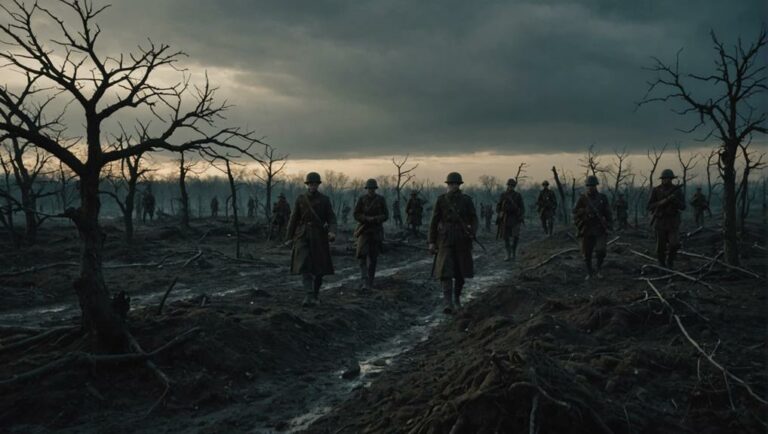Explore the harrowing reality of World War I through the vivid poetry of frontline soldiers like Wilfred Owen and Siegfried Sassoon, who captured the brutal essence of conflict.
Discover how these poignant verses, including John McCrae's emblematic 'In Flanders Fields,' serve as enduring symbols of sacrifice and remembrance.
Importance of War Poetry
War poetry from World War I plays an important role in conveying the stark realities and emotional depths of the battlefield, offering readers an unfiltered glimpse into the soldiers' harrowing experiences. One of the most poignant examples is Wilfred Owen's 'Dulce et Decorum Est.' This poem vividly depicts the horrors of trench warfare, challenging the romanticized notion of dying for one's country.
Owen, a soldier poet himself, uses stark imagery to illustrate the gruesome injuries and psychological torment faced by those on the front lines.
War poetry serves not just as a historical record but also as a powerful emotional conduit. It captures the terror and futility of conflict, enabling readers to understand the profound human cost of war.
During World War I, over 2,200 writers, including a significant number of women, contributed to this literary canon. Their works remain an essential part of literary history, evoking strong emotions and reflections.
Prominent War Poets
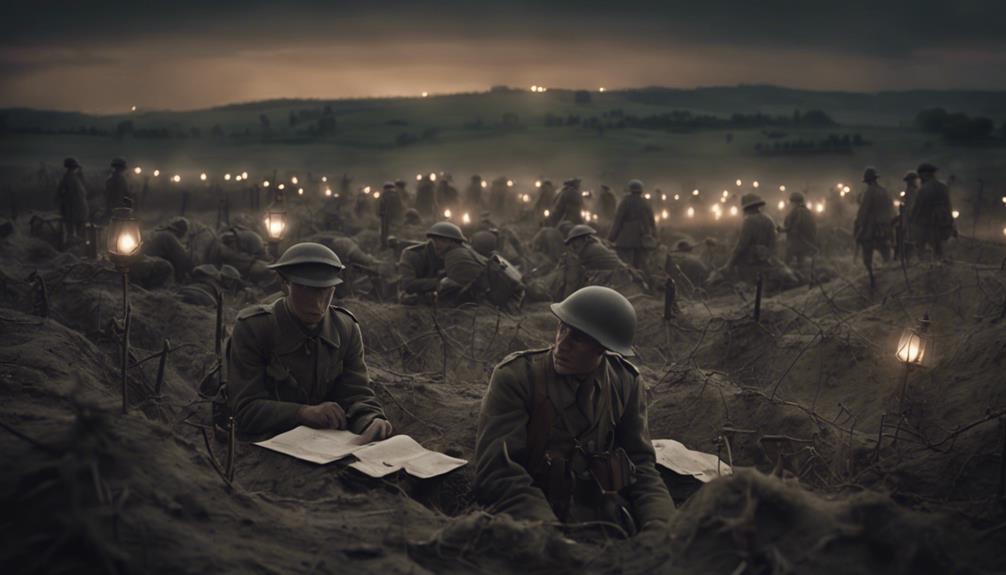
Among the most prominent war poets of World War I, Wilfred Owen stands out for his visceral depictions of the battlefield's brutal realities. Owen's poignant verses, such as those in 'Dulce et Decorum Est,' vividly convey the horrors of gas warfare and the disillusionment of soldiers. His work remains a powerful evidence to the grim everyday experiences of the trenches.
Siegfried Sassoon, another key figure, utilized his poetry to criticize the war effort. His candid, protest-filled verses starkly contrasted with the patriotic fervor of the time, offering a raw, unfiltered perspective on the conflict. Sassoon's writing not only highlighted the grim conditions but also questioned the political motives behind the war.
Rupert Brooke, in contrast, provided a more conventional and inspirational view of the war. His sonnets, written before his death in 1915, celebrated the nobility of sacrifice and duty, reflecting an idealistic vision of warfare.
John McCrae's 'In Flanders Fields' became an enduring symbol of remembrance. This Canadian physician turned poet captured the somber duty to honor fallen soldiers.
Lastly, Vera Brittain offered a unique perspective as a female war poet, highlighting the war's impact on women and civilians. Her moving poetry provides invaluable insights into the broader societal consequences of the conflict.
Iconic War Poems

Drawing from the profound emotional and psychological experiences of the battlefield, iconic war poems such as Wilfred Owen's 'Dulce et Decorum Est' and Siegfried Sassoon's 'The One-Legged Man' offer a stark, unfiltered portrayal of World War I's harrowing realities. Owen's 'Dulce et Decorum Est' graphically illustrates the horror of a gas attack, vividly capturing the soldiers' agony as they struggle through the trenches. His use of visceral imagery and haunting language dismantles the romanticized notion of war, revealing its brutal truth.
In contrast, Sassoon's 'The One-Legged Man' employs bitter irony to critique the physical and psychological toll on soldiers. The poem's focus on a maimed veteran highlights the war's lasting impact, extending beyond the battlefield into the lives of those who survived. Through these war poems, both poets channel their direct experiences to convey a sobering narrative of World War I.
Additionally, John McCrae's 'In Flanders Fields' and Robert Graves' 'A Dead Boche' provide different perspectives, yet each reinforces the war's devastating effects. McCrae honors the fallen, while Graves reflects on shared humanity. These iconic works collectively underscore the profound impact of World War I poetry, echoing the voices of those who endured its horrors.
Themes in War Poetry
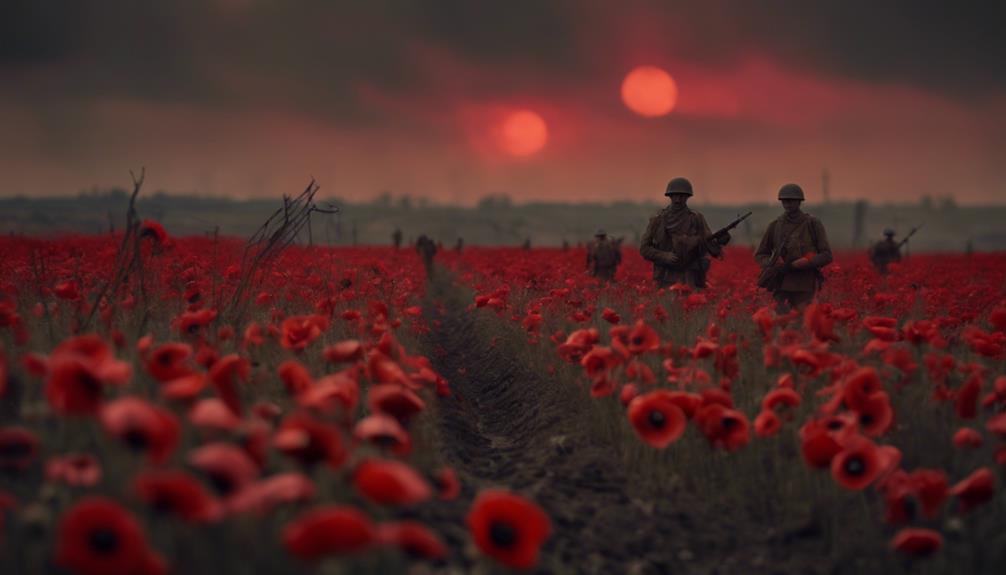
Exploring the themes in war poetry reveals how poets encapsulate the emotional and societal repercussions of World War I, delving into complex concepts such as sacrifice, loss, and the stark reality of conflict. Wilfred Owen's 'Dulce et Decorum Est' exemplifies this, critiquing the romanticized view of war by exposing its brutal truths. Owen's vivid portrayal of gas attacks and the agony of soldiers underscores the immense sacrifice and suffering endured.
In the domain of World War Poetry Digital, you'll find numerous poems that address:
- Sacrifice: Highlighting not just the physical loss of life but the emotional and psychological toll on those left behind.
- Loss: Reflecting on the personal and collective grief experienced by societies and families.
- Nature: Using landscapes and natural elements as metaphors for the devastation and desolation caused by war.
These themes aren't just historical; they resonate with readers today, offering insight into the human cost of conflict. By examining these recurring motifs, you can gain a deeper appreciation for how poets like Owen used their craft to critique war and memorialize its profound impact. The enduring significance of these themes safeguards that the lessons of World War I are never forgotten.
Emotional Impact
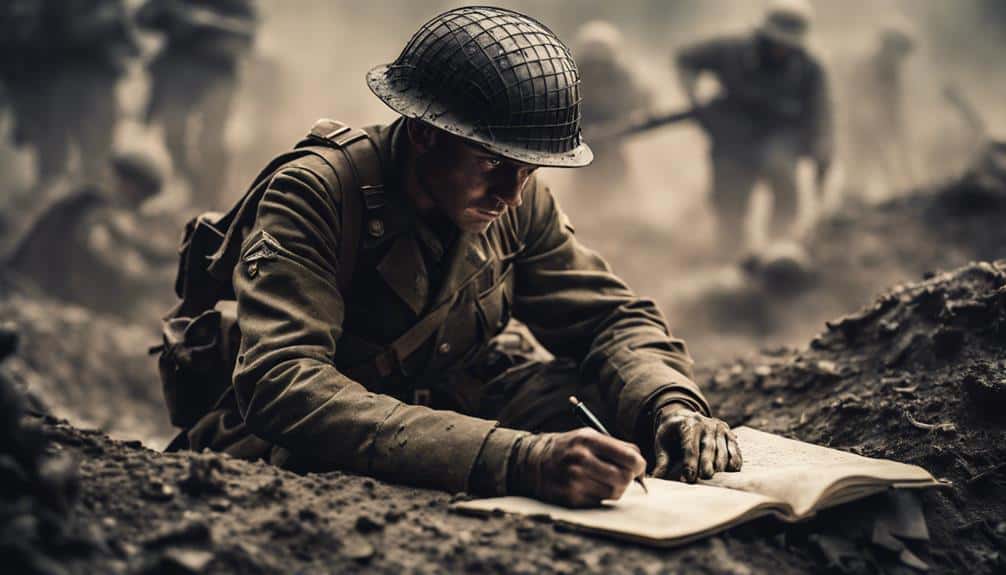
When reading the works of war poets like Wilfred Owen and Siegfried Sassoon, you can't help but be struck by the profound emotional impact their verses convey, as they meticulously portray the harrowing realities of World War I. Owen's 'Dulce et Decorum Est' exemplifies this emotional depth, vividly depicting the agonies of a gas attack and challenging the romanticized view of war as noble.
War poets like Owen and Sassoon shattered traditional notions of heroism, instead spotlighting the physical and psychological tolls on soldiers. Their use of vivid imagery and sensory details immerses you in the trenches' grim futility and senselessness.
In 'Dulce et Decorum Est,' Owen's descriptions of 'blood-stained' soldiers evoke a visceral reaction, making you feel the exhaustion and despair they endured.
The emotional impact doesn't stop at visceral descriptions; it extends to a profound critique of war's glorification. Through irony and sarcasm, these poets lay bare the suffering and loss experienced by individuals, compelling you to confront the human cost of the Great War.
This enduring emotional resonance guarantees that World War I poetry remains a powerful reminder of the conflict's devastating consequences.
Poetic Devices
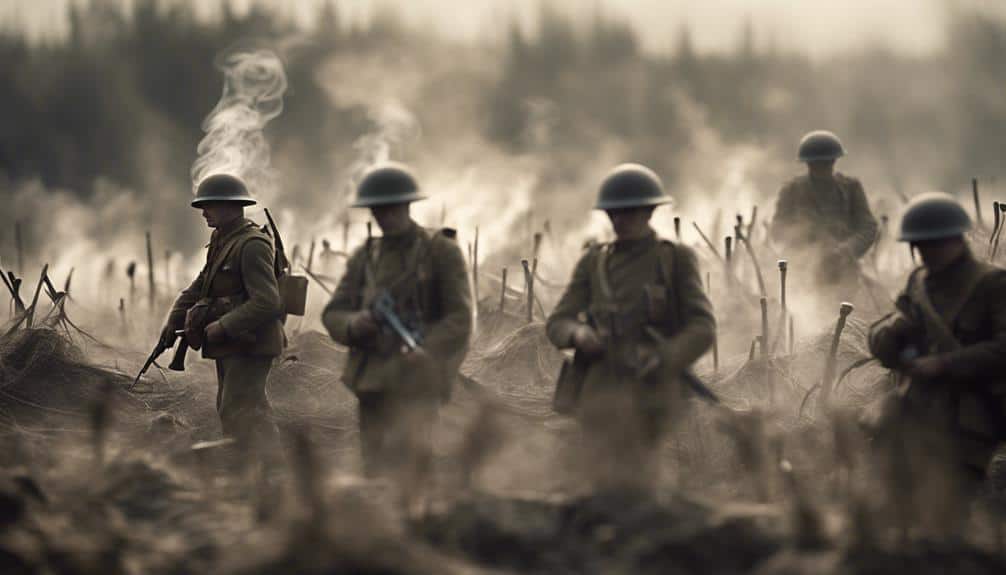
In their poignant verses, war poets masterfully employed poetic devices to convey the stark realities and deeper meanings of World War I. Wilfred Owen's 'Dulce et Decorum Est' stands as a prime example, utilizing vivid imagery to depict the brutality of gas attacks. You can almost see the 'white eyes writhing' and hear the 'gargling' as Owen immerses you in the horrific scene with rich sensory details.
Other poets like John McRae used symbolism to convey deeper meanings. In 'In Flanders Fields', McRae's poppies symbolize remembrance and the sacrifice of soldiers. This powerful symbol resonates deeply, transforming simple flowers into lasting emblems of loss and memory.
Irony also plays an essential role in war poetry. For instance, Siegfried Sassoon's satirical works challenge the glorification of conflict, using irony to critique the romanticized view of war.
These poetic devices not only enhance the emotional impact of the poems but also deepen your understanding of the complex and often contradictory nature of war.
- Imagery: Owen's graphic descriptions in 'Dulce et Decorum Est'.
- Symbolism: McRae's poppies in 'In Flanders Fields'.
- Irony: Sassoon's satirical critique of war glorification.
Commemoration
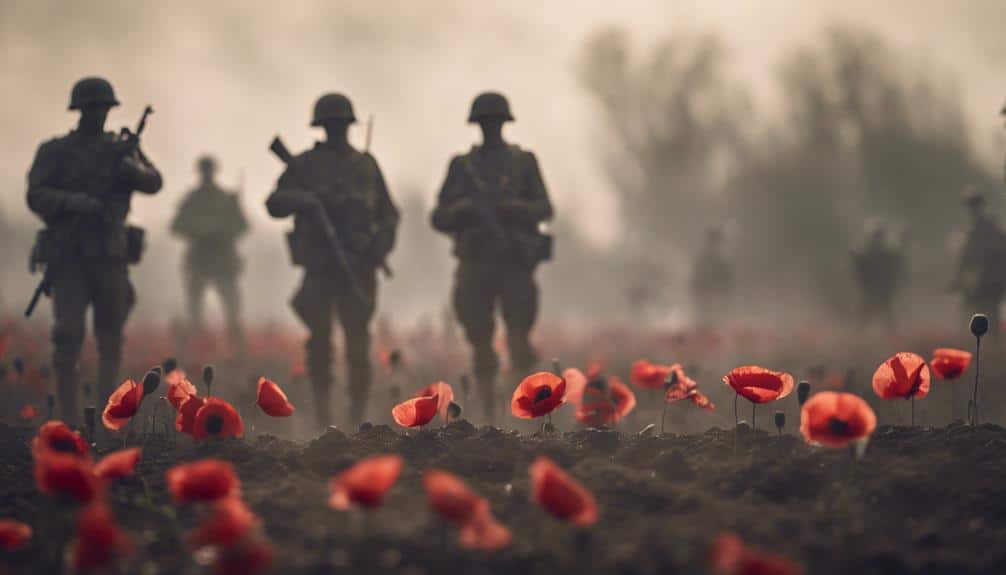
Commemorating the First World War poets isn't just about honoring their literary contributions; it's a profound act of remembering the sacrifices and the haunting realities they so vividly portrayed.
Events like Armistice Day serve as poignant reminders of the impact of war poetry. The Cenotaph in London stands as a symbol of remembrance for the fallen soldiers of World War I, echoing the sentiments captured in poems like Wilfred Owen's 'Dulce et Decorum Est.'
First World War poetry readings and events are held worldwide, providing a platform to reflect on the devastating consequences of conflict. Schools and organizations often use these poems to educate about the grim realities of war, ensuring that the messages of the War Poets remain relevant and impactful.
Moreover, the influence of First World War poetry extends beyond literature, shaping contemporary anti-war movements. These poems serve as powerful reminders of the sacrifices made during the war, reinforcing the importance of remembrance.
Wilfred Owen's Legacy
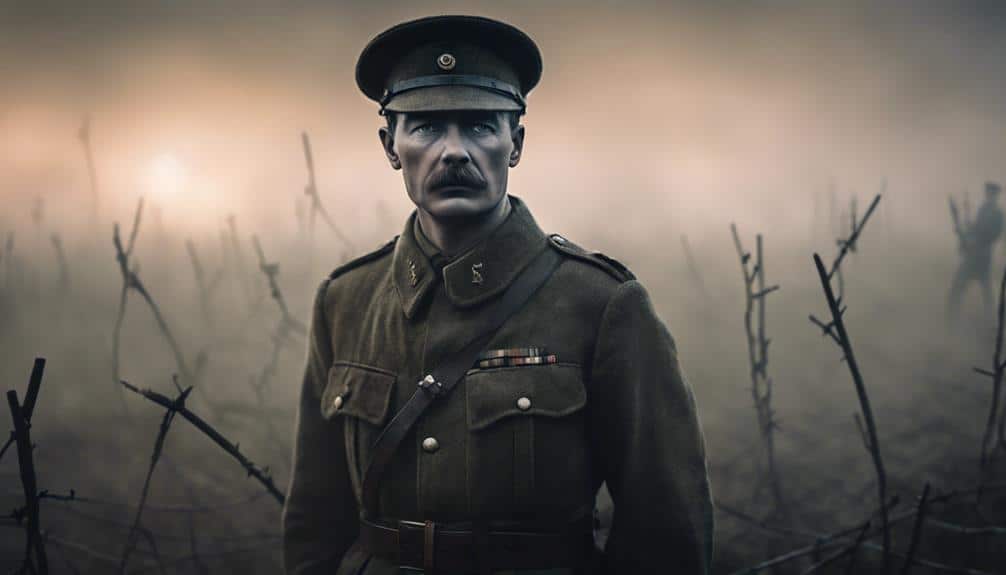
In examining Wilfred Owen's legacy, you'll find that his poetic influence is profound, shaped by his harrowing experiences on the frontlines.
His works critically assess the glorification of war, challenging the romanticized notions of heroism prevalent at the time.
Through his vivid and emotive poetry, Owen offers an unfiltered critique of the brutality and futility of conflict, ensuring his voice remains a powerful demonstration to the horrors of WWI.
Owen's Poetic Influence
Wilfred Owen's influence as a war poet profoundly reshaped how you comprehend and interpret the human suffering and futility of World War I. Through his iconic war poems like 'Dulce et Decorum Est' and 'Anthem for Doomed Youth,' Owen vividly depicted the grim realities of life in the trenches. His work stands as a testament to the brutal and senseless nature of conflict, challenging the romanticized perceptions of war.
Owen's poetic influence extends beyond mere description; it draws you into the visceral experience of soldiers. His close relationship with Siegfried Sassoon helped refine his poetic voice, leading to powerful portrayals of war's physical and emotional toll. The enduring relevance of Owen's work lies in its ability to connect with readers on a profound level, evoking empathy and reflection.
- Vivid Imagery: Owen's use of stark, haunting imagery brings the horrors of war to life.
- Emotional Depth: His poems convey deep emotional resonance, highlighting the despair and hopelessness felt by soldiers.
- Critical Perspective: Owen's work critiques the glorification of war, exposing its true, devastating impact.
Wilfred Owen's contributions have left an indelible mark on war literature, ensuring that the harsh truths of World War I are neither forgotten nor misunderstood.
Experiences on Frontlines
Owen's firsthand experiences on the frontlines, marked by relentless trench warfare and harrowing gas attacks, imbue his poetry with an authenticity that captures the true horrors of World War I. His time in the trenches exposed him to the brutal realities faced by young men, many of whom were ill-prepared for the sheer scale of violence and chaos.
This firsthand experience is evident in his vivid descriptions and emotional depth, particularly in works like 'Dulce et Decorum Est' and 'Anthem for Doomed Youth'.
Owen's depiction of gas attacks, with their suffocating and deadly impact, highlights the indiscriminate nature of modern warfare. The graphic imagery in his poetry isn't merely artistic; it stems from real-life encounters that left indelible marks on his psyche.
Trench warfare, with its constant threat of death and deplorable living conditions, further shaped his view of the conflict, providing a stark contrast to the glorified visions of war often propagated at the time.
Critique of War
Few poets have left such an indelible mark on war literature as Wilfred Owen, whose works unflinchingly critique the glorification of conflict and reveal the grim realities of World War I. Owen's legacy lies in his ability to debunk the romanticized notion of war as a noble pursuit. His poem, 'Dulce et Decorum Est,' starkly contrasts the idealized vision of a soldier's life with the harrowing experiences faced by young men on the front lines.
Owen's critiques are multifaceted and profound:
- Decorum: He dissects traditional values and the notion of "decency" in war, exposing the moral disarray that accompanies conflict.
- Lie: Through 'Dulce et Decorum Est,' Owen famously denounces the age-old saying that it's sweet and fitting to die for one's country, labeling it a dangerous lie.
- World: His works provide a global perspective, urging readers to reconsider the widespread acceptance of war.
Sassoon's Influence

Siegfried Sassoon deeply shaped Wilfred Owen's poetic development, guiding him towards a more passionate and honest depiction of the war's horrors. As war poets, both Owens and Sassoon shared a critical view of pro-war propaganda in England, acknowledging the significance of capturing the brutal realities of WWI through their poetry.
Sassoon's influence on Owen was significant, providing him with the gentle support and guidance necessary to refine his poetic voice. Their shared ideals and experiences on the battlefield fostered a deep emotional connection, potentially extending beyond mere friendship.
This bond enabled Sassoon to mentor Owen effectively, encouraging him to explore the raw, painful aspects of war that many preferred to overlook. Owen's admiration for Sassoon is evident in his heartfelt letters, where he expressed profound gratitude and affection for his mentor.
Through Sassoon's influence, Owen's poetry evolved to portray the stark truth of the war, rejecting the sanitized narratives propagated by the media. This transformation not only solidified Owen's place among the great war poets but also guaranteed that the harrowing experiences of soldiers were immortalized in literature.
Critique of Propaganda
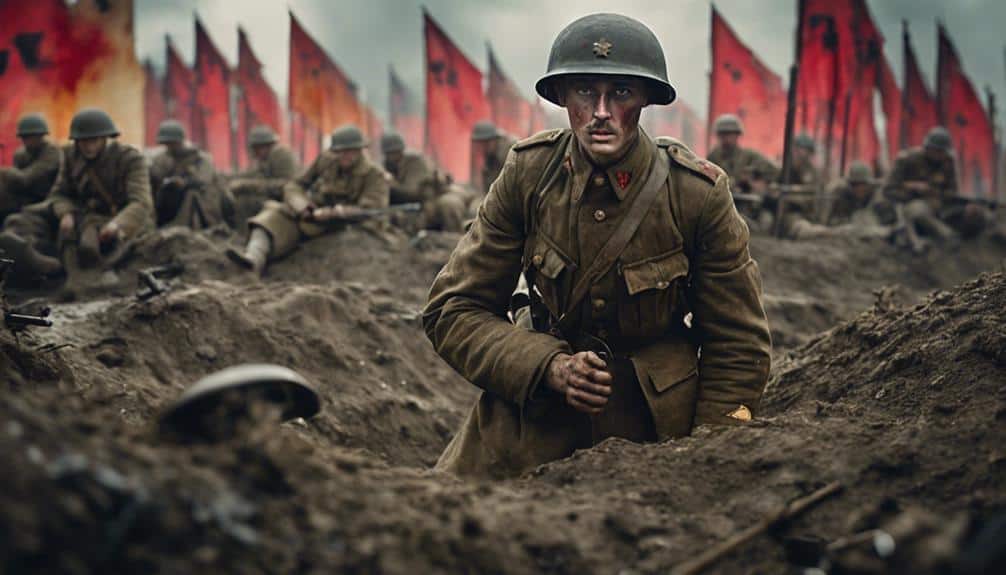
Building on their shared commitment to depicting the stark realities of war, Owen and Sassoon rigorously critiqued the pervasive pro-war propaganda of their time. These war poets didn't shy away from exposing the harsh realities of conflict, challenging societal complacency that allowed glorified images of war to thrive. Their works aimed to dismantle misleading narratives and evoke a deeper understanding of war's true consequences.
Wilfred Owen's poem 'Dulce et Decorum Est' epitomizes this critique by vividly portraying the grotesque suffering of soldiers, countering the notion that it's sweet and honorable to die for one's country.
Similarly, Siegfried Sassoon's protest letter to the War Department explicitly condemned the misleading propaganda that painted war in a heroic light.
To further understand their critique, consider:
- Owen's graphic depictions: His descriptive language shattered illusions of war's nobility.
- Sassoon's direct confrontation: His bold criticism directly targeted those perpetuating propaganda.
- Empathy and reflection: Their writings were designed to provoke thought and empathy, urging readers to question pro-war narratives.


